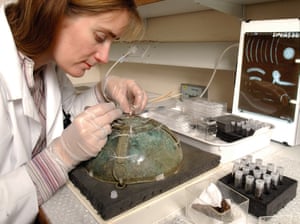An Anglo-Saxon burial chamber found on a grassy verge next to a busy road and not far from an Aldi is being hailed as Britain’s equivalent of Tutankhamun’s tomb.
Archaeologists on Thursday will reveal the results of years of research into the burial site of a rich, powerful Anglo-Saxon man found at Prittlewell in Southend-on-Sea, Essex.
When it was first discovered in 2003, jaws dropped at how intact the chamber was. But it is only now, after years of painstaking investigation by more than 40 specialists, that a fuller picture of the extraordinary nature of the find is emerging.
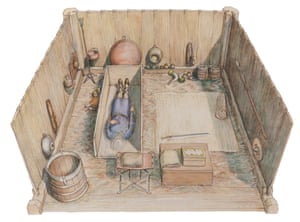
Sophie Jackson, director of research at Museum of London Archaeology (Mola), said it could be seen as a British equivalent to Tutankhamun’s tomb, although different in a number of ways.
For one thing it is in free-draining soil, meaning everything organic has decayed. “It was essentially a sandpit with stains,” she said. But what a sandpit. “It was one of the most significant archaeological discoveries we’ve made in this country in the last 50 to 60 years.”

-
The remains of one of the wooden drinking cups which provided the crucial material for carbon dating the burial chamber, and the top of a wooden drinking bottle with decorated gold neck, found in the burial chamber.


The research reveals previously concealed objects, paints a picture of how the chamber was constructed and offers new evidence of how Anglo-Saxon Essex was at the forefront of culture, religion and exchange with other countries across the North Sea.
It also throws up a possible name for the powerful Anglo-Saxon figure for whom the grave was built.
Previously, the favourite suggestion was a king of the East Saxons, Saebert, son of Sledd. But he died about 616 and scientific dating now suggests the burial was in the late-6th century, about 580.
That means it could be Saebert’s younger brother Seaxa although, since the body has dissolved and only tiny fragments of his tooth enamel remain, it is impossible to know for certain.
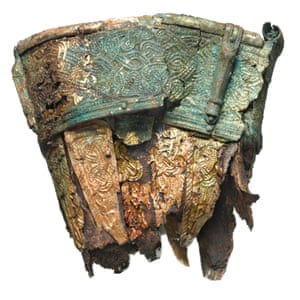
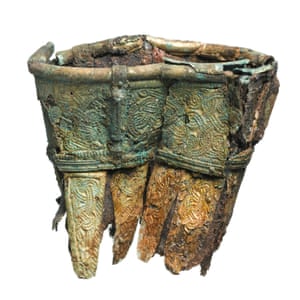
Gold foil crosses were found in the grave which indicate he was a Christian, a fact which has also surprised historians.
Sue Hirst, Mola’s Anglo-Saxon burial expert, said that date was remarkably early for the adoption of Christianity in England, coming before Augustine’s mission to convert the country from paganism.
But it could be explained because Seaxa’s mother Ricula was sister to king Ethelbert of Kent who was married to a Frankish Christian princess called Bertha. “Ricula would have brought close knowledge of Christianity from her sister-in-law.”
Recreating the design of the burial chamber has been difficult because the original timbers decayed leaving only stains and impressions of the structure in the soil.
But it has been possible. The Mola team estimates it would have taken 20 to 25 men working five or six days in different groups to build the chamber and would have involved felling 13 oak trees.
“It was a significant communal effort,” said Jackson. “You’ve got to see this burial chamber as a piece of theatre. It is sending out a very strong message to the people who come and look at it and the stories they take away from it. It says ‘we are very important people and we are burying one of our most important people’.”
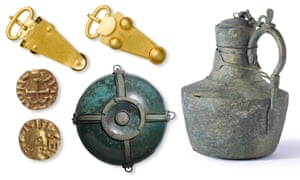
-
Object found (clockwise from top left) include a gold belt buckle, a copper alloy flagon from the Mediterranean, a decorative hanging bowl, and gold coins.
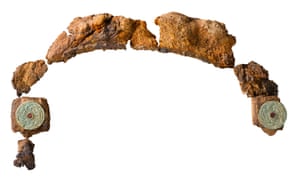
Objects identified in the grave include a wooden lyre – the ancient world’s most important stringed instrument – which had almost entirely decayed apart from fragments of wood and metal fittings preserved in a soil stain.
Micro-excavation in the lab has revealed it was made from maple, with ash tuning pegs, and had garnets in two of the lyre fittings which are almandines, most likely from the Indian subcontinent or Sri Lanka. It had also been broken in two at some point and put back together.
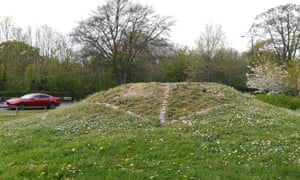
-
The burial site by the side of a road in Essex, believed to be that of Seaxa, brother of King Saebert, who died between 575 and 605AD.
The burial chamber was discovered only because of a proposal to widen the adjacent road. It was fully excavated and the research has been undertaken by experts in a range of subjects including Anglo-Saxon art, ancient woodworking, soil science and engineering.
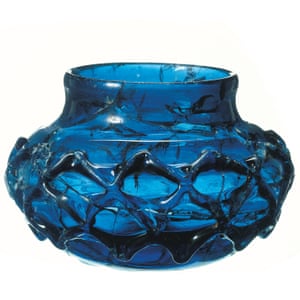

The new Mola findings are published on Thursday ahead of a long-awaited new permanent display of Prittlewell princely burial objects at Southend Central Museum. It opens on Saturday and will include objects such as a gold belt buckle, a Byzantine flagon, coloured glass vessels, an ornate drinking horn and a decorative hanging bowl. People will also be able to explore the burial chamber online at www.prittlewellprincelyburial.org.
Essex has sometimes been seen as something of an Anglo-Saxon backwater but the Prittlewell burial chamber suggests otherwise.
“What it really tells us,” said Hirst, “is that the people in Essex, in the kingdom of the East Saxons at this time, are really at the forefront of the political and religious changes that are going on.”
